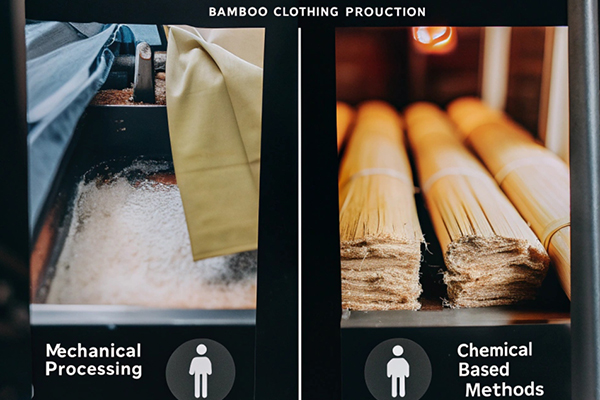Bamboo clothing has gained a reputation as a sustainable alternative to traditional fabrics like cotton and polyester. It’s often marketed as an eco-friendly option due to bamboo’s rapid growth and minimal resource requirements1. But is bamboo clothing as green as it seems?
While bamboo clothing can be eco-friendly under certain conditions, its environmental benefits depend on how it is grown and processed.
Let’s explore whether bamboo clothing is good for the environment, how quickly it biodegrades, and the potential environmental concerns associated with its production.
Is bamboo clothing good for the environment?
Bamboo is often praised as a sustainable resource, but turning it into clothing involves processes that can affect its environmental impact.
Bamboo clothing is good for the environment when responsibly produced, but traditional chemical-based processing methods can offset its benefits.

Why Bamboo is an Eco-Friendly Resource
-
Rapid Growth
- Bamboo is one of the fastest-growing plants, with some species growing up to 3 feet per day.
- It regenerates naturally without needing to be replanted, reducing soil erosion.
-
Minimal Water Usage
- Unlike cotton, which requires large amounts of water to grow, bamboo thrives with natural rainfall.
-
No Pesticides Required
- Bamboo is naturally resistant to pests, eliminating the need for harmful pesticides or fertilizers.
-
- Bamboo absorbs large amounts of CO2 while releasing 35% more oxygen than equivalent stands of trees, making it a carbon-neutral crop.
Processing Challenges
While growing bamboo is environmentally friendly, processing it into fabric often involves:
- Chemical Processing3: The most common method to produce bamboo rayon uses chemicals like sodium hydroxide and carbon disulfide, which can harm workers and pollute the environment.
- Energy Consumption: Mechanical processing, which is more eco-friendly, requires significant energy and is less commonly used due to higher costs.
How long does bamboo fabric take to biodegrade?
Biodegradability is an essential factor in assessing a fabric’s environmental impact.
Bamboo fabric biodegrades in about 1–5 years under natural conditions, making it more sustainable than synthetic materials like polyester.

Factors That Affect Biodegradation
-
Type of Bamboo Fabric
- Natural Bamboo Fiber: Mechanically processed bamboo fabric decomposes faster due to its untreated, natural state.
- Bamboo Rayon/Viscose: Chemically processed bamboo takes longer to break down because of added synthetic substances.
-
Environmental Conditions
- Composting: Bamboo fabric biodegrades faster in warm, moist environments with active microorganisms.
- Landfills: In landfills with limited oxygen, biodegradation slows significantly.
-
Additives and Treatments
- Fabrics treated with dyes, synthetic finishes, or coatings may delay decomposition.
| Type of Bamboo Fabric | Time to Biodegrade |
|---|---|
| Mechanically Processed | 1–2 years |
| Chemically Processed (Rayon) | 3–5 years |
Biodegradability vs. Synthetic Materials
- Bamboo fabric decomposes much faster than polyester, which can take hundreds of years to break down.
- Proper disposal, such as composting untreated bamboo fabric, ensures it returns to the earth without leaving harmful residues.
What are the environmental issues with bamboo?
Despite its many advantages, bamboo clothing isn’t without environmental concerns, especially during cultivation and processing.
The primary environmental issues with bamboo involve large-scale farming practices, chemical processing, and misleading marketing claims.

1. Large-Scale Bamboo Farming
- Deforestation
- In some regions, forests are cleared to make way for commercial bamboo plantations, which disrupt ecosystems and reduce biodiversity.
- Monoculture Farming
- Growing bamboo in monocultures can deplete soil nutrients and harm local wildlife habitats.
2. Chemical Processing
- Most bamboo clothing is made using the rayon/viscose process, which relies on chemicals like sodium hydroxide and carbon disulfide.
- Improper disposal of chemical waste can pollute water sources and harm ecosystems.
3. Greenwashing in Marketing
- Many brands market bamboo clothing as “natural” and “eco-friendly” without addressing the environmental impact of chemical processing.
- Misleading claims can give consumers a false sense of sustainability.
4. Transportation Emissions
- Bamboo is primarily grown in Asia, meaning transporting raw materials or finished products to other parts of the world generates significant carbon emissions.
How to Mitigate Environmental Issues
-
Choose Certified Bamboo4
- Look for certifications like OEKO-TEX or FSC (Forest Stewardship Council) to ensure sustainable farming and ethical production.
-
Support Brands Using Closed-Loop Processes
- Some manufacturers use closed-loop systems that capture and reuse chemicals, minimizing pollution.
-
Opt for Mechanically Processed Bamboo5
- Although less common, mechanically processed bamboo (bamboo linen) is a truly sustainable option.
Conclusion
Bamboo clothing has the potential to be eco-friendly, offering benefits like rapid growth, minimal water use, and biodegradability. However, its sustainability depends heavily on how it’s processed and produced. Mechanically processed bamboo fabrics are more environmentally friendly, while chemical processing raises concerns about pollution and worker safety. By choosing certified, responsibly produced bamboo clothing, consumers can enjoy its benefits while minimizing its environmental impact. Bamboo’s promise lies in thoughtful production practices and greater transparency, making it a material with untapped potential in sustainable fashion.
-
Learn why bamboo grows rapidly and uses few resources. ↩
-
Discover how bamboo absorbs CO2 and produces oxygen. ↩
-
Understand the environmental concerns of bamboo rayon production. ↩
-
Find out how FSC certification ensures sustainable bamboo. ↩
-
Learn about the benefits of mechanically processed bamboo. ↩













